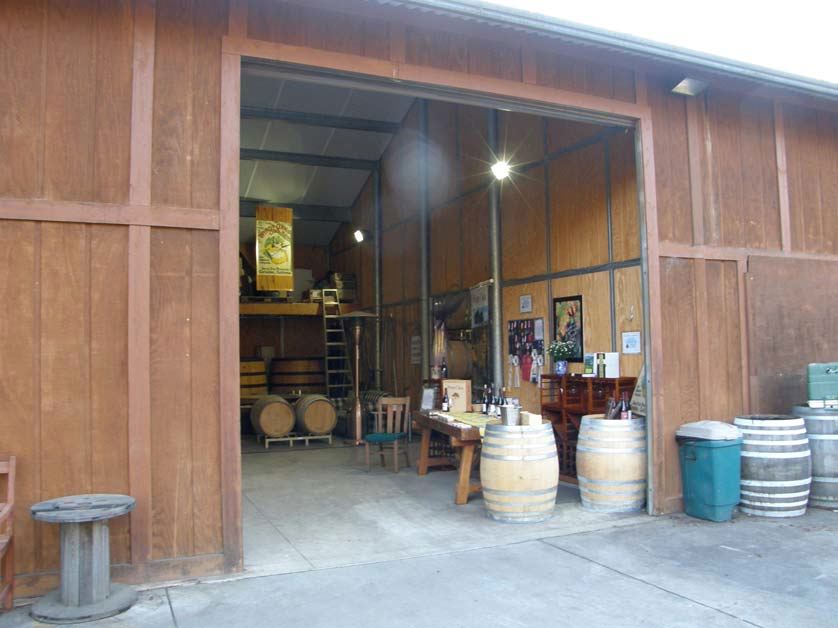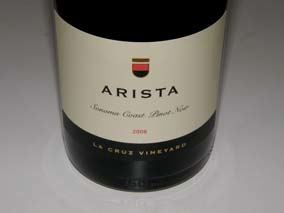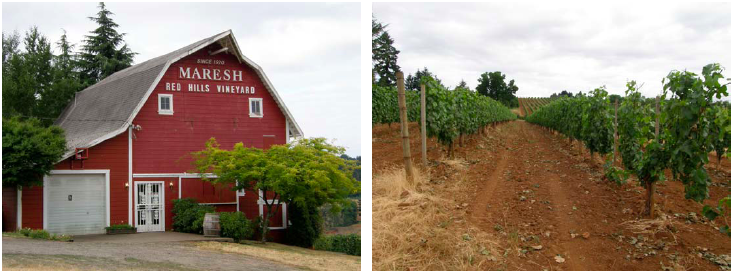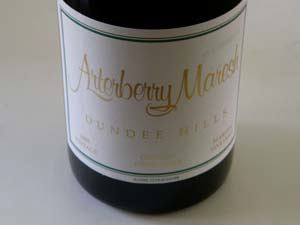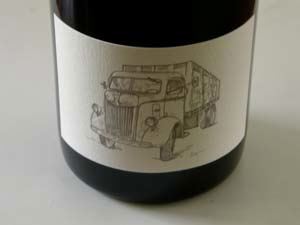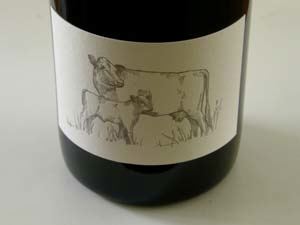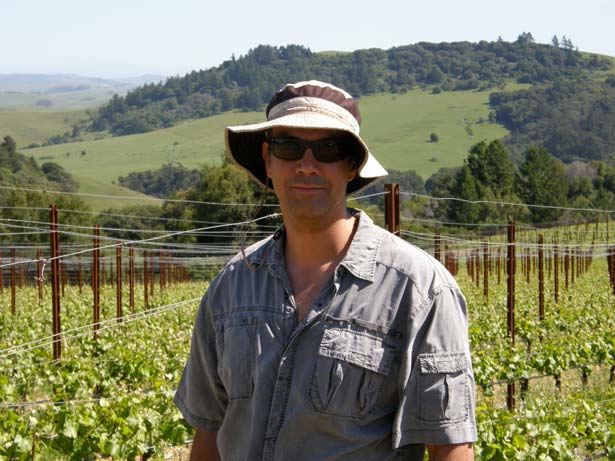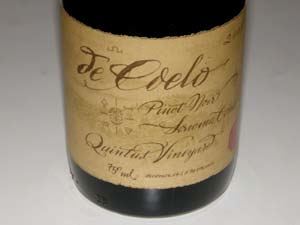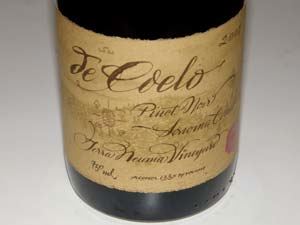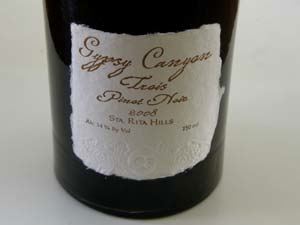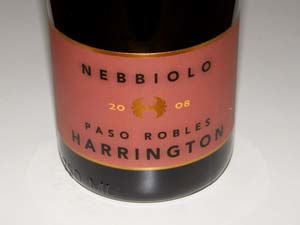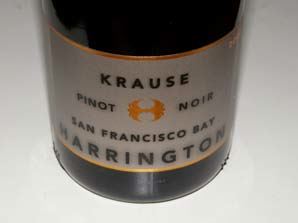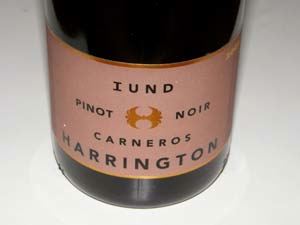Arista Winery
Russian River Valley, California
Arista Winery is one of the new bright stars on Westside Road in the Middle Reach sub-region of the Russian
River Valley. The estate consists of 36 acres that was originally a part of a Southern Pomo Indian village
named Budutcilan. In the mid 1800s, the area was a prime growing site for the lumbar industry and later for
hops. The McWilliams family acquired the property in 2004 and in mid 2005 the Arista Estate was opened to
the public.
Arista winery is a small, family operated affair. The patriarch is Al McWilliams, a former orthodontist who had
previously farmed Pine Mountain Vineyards in the Alexander Valley with brother-in-law John Copeland. The
McWilliams could not use their family name for their Russian River Valley winery since E. & J. Gallo owned a
similarly named winery in Australia. The letter sent to the McWilliams family from the E. & J. Gallo attorney
suggested two alternative names and Arista was chosen.
Currently, Arista sources Pinot Noir from several Sonoma County vineyards. 10 acres of high density vines
have been planted on the estate property by vineyard manager Ulises Valdez, and a Pinot Noir from the site
will be produced beginning in 2010. Ben McWilliams directs vineyard development and oversees grower
relations. Plans are afoot to soon build a winery on the estate property. The winemakers are veteran Leslie
Sisneros, a University of California at Davis graduate who crafted Pinot Noir for Kendall Jackson Wine Estates
for thirteen years, and young Mark McWilliams. Mark developed a passion for wine fresh out of college
working for Kendall Jackson Wine Estates leading to his interest in winemaking. Besides assisting Sisneros,
he manages the day to day operations of the winery.
The emphasis at Arista Winery is on vineyard-designated wines including Pinot Noir, Zinfandel, Pinot Gris, and
Gewürztraminer, all produced in lots of 80 to 300 cases. The wines have been very favorably reviewed in the
wine press, and as a result, the mailing list of customers has become crowded, but is still open to newcomers.
The single vineyard wines are only available to mailing list members. Some of the larger production appellation
wines are sold online, distributed to retail wine stores and offered in small amounts in the tasting room. The
winery was not included in John Winthrop Haeger’s comprehensive book, Pacific Pinot Noir, (published in 2008
and not on Haeger’s radar yet), but as the Pinot Noirs reviewed below from the 2008 vintage demonstrate, this
producer definitely deserves your attention. The wines all displayed admirable balance, a sign of impeccable
winemaking.
The winery’s beautiful tasting room is surrounded by a serene, Japanese garden. Located at 7015 Westside
Road, visitors are welcomed daily from 11-5. The venue is available for weddings, corporate meetings and
other special occasions. The winery’s website is www.aristawinery.com and phone is 707-473-0606. The
winery is currently offering a “Taste of Arista” gift box, which includes six 50 ml tasting bottles of 2008 Arista
wines ($35), a unique way to sample several wines before buying.
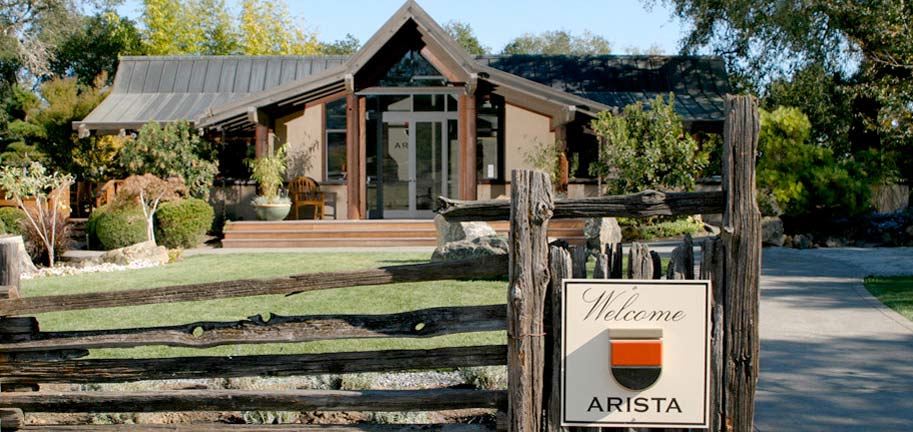
2008 Arista Russian River Valley Pinot Noir
14.3% alc., pH 3.80, 616 cases, $44. Released spring 2010.
Aged in 40% new French oak barrels. 92% Russian River Valley, 8% Sonoma Coast.
·
Shy aromas of black
cherries and red berries picking up some intensity over time in the glass. Earth-kissed black cherry and berry
flavors with a slight oak and tobacco edge. On the lean side, but has some charming silkiness on the palate.
A reliable daily drinker. Decent.
2008 Arista Longbow Russian River Valley Pinot Noir
14.5% alc., pH 3.80, 430 cases, $44. Released
spring 2010. Sold out. Aged in 65% new French oak.
·
The nose is closed for business with oak at the forefront
and only a hint of mixed purple berry and dark stone fruit peaking out over time in the glass. A mediumweighted
fruit-driven wine with flavors of black cherries, black currants and plums veering to the ripe side with
oak in the background. Silky smooth with mild tannins. Needs more time. Tasted twice. Good.
2008 Arista Sonoma Coast Pinot Noir
14.3% alc., pH 3.80, 920 cases, $34.
Released spring 2010. Aged in 12% new French oak, 24% 1 year oak and 64%
seasoned oak.
·
The vibrant aromas of dark berries and cherries, oak and
mushroom really grab your attention. Tasty core of berries and plums with a
sidecar of tea and earth flavors. The fruit flavors have impressive intensity and
persistence, and the silky texture adds to the appeal. This is a wine that grabs
your senses and holds on. Good.
2008 Arista Bacigalupi Vineyard Russian River Valley Pinot Noir
14.4% alc., pH 3.52, 220 cases, $56.
Released fall 2010. Helen and Charles Bacigalupi’s first plantings in the Middle Reach of the Russian River
Valley date from the early 1960s. Carl Wente sold the Bacigalupi family Pinot Noir cuttings from his vineyard in
the Livermore Valley. This wine contains the old Wente Selection Pinot Noir and Pommard clone from this
historic vineyard. Aged in 50% new French oak barrels.
·
Moderately light reddish-purple color in the glass.
Demure aromas of spiced Bing cherries picking up more of a savory, leafy bent over time in the glass. Discreet
array of medium-weighted dark red Pinot fruit flavors with notes of herbs and mushroom. A relatively simple
and youthful wine now, but with impeccably balanced tannins and acidity, should age nicely in the bottle.
Good.

2008 Arista La Cruz Vineyard Sonoma Coast Pinot Noir
14.3% alc., pH 3.68, 258 cases, $56.
Released fall 2010. From the southernmost end of the Sonoma Coast appellation. Plantings here were
among the first in the Petaluma Valley dating to 1994. Aged in 50% new French oak barrels.
·
Seductive
aromas of fresh black cherries with hints of oak and spice box. A gorgeous wine in the mouth with bright
flavors of black cherry and black raspberry with a complimentary underpinning of oak spice and toast.
Perfect harmony creating a wine that urges you to take another sip. I would love some duck confit with
this beauty.

2008 Arista Mononi Vineyard Russian River Valley Pinot Noir
14.5%
alc., pH 3.63, 224 cases, $56. Released fall 2010. From a 10-year-old
vineyard planted to Dijon clones 113 and 115. Aged in 50% new French
oak barrels.
·
Stunning and nuanced aromatic profile featuring spiced
berries, rose petals and violets picking up intensity with time in the glass.
This wine has all the charm and delicacy one could asked for combined
with a tasty and hearty core of cherry, strawberry and cola flavors, harmoniously
supported by soft tannins and bright acidity. The whole package.
2008 Arista Toboni Vineyard Russian River Valley Pinot Noir
14.5% alc., pH 3.63, 256 cases, $56. Released fall 2010. This 15-acre vineyard is located just off Olivet Lane and is planted to Dijon 115, 667, 777 and Pommard 5 clones. Aged in 50% new French oak barrels.
·
Brooding nose with scents of dark fruits, raisin and cigar box. The most intensely fruity and tannic wine in the Arista lineup but retaining an appealing silky mouth feel. The berry, cassis, and plum flavors veer to the ripe and sweet side with oak char providing a backup note. Not shy, and quite flavorful. Very Good
Arterberry Maresh
Dundee Hills, Willamette Valley, Oregon
The Maresh family is closely tied to the history of Pinot Noir in the Williamette Valley. Jim and Loie Maresh
were Wisconsin natives who met as students at Marquette University. The couple bought a 26-acre farm in the
Dundee Hills in 1959. They expanded their holdings while Jim worked for Dunn & Brandstreet and served as a
reserve officer in the Navy in Portland. Their home was relatively isolated, but they enjoyed the life of farming
cherries, nuts and prunes.
Dick Erath, who had begun to farm 49-acre vineyard in the Chehalem Mountains in 1968, encouraged the
Maresh family to grow wine grapes on their site. They followed his suggestion and in 1970 planted three acres
of Pinot Noir vines. At the time, David Lett (The Eyrie Vineyards) had the only Pinot Noir vineyard in Yamhill
County. The Maresh Vineyard was the fifth to be planted in Oregon and the first vineyard developed on Worden
Hill Road outside of Dundee, now a major epicenter of Pinot Noir in the Willamette Valley.
Jim and Loie had five children. One daughter, Martha, married Fred Arterberry who was one of the first Oregon
winemakers to have a degree from the University of California at Davis. Arterberry produced many award winning
wines including the first sparkling wine in Oregon. Fred Arterberry’s 1985 Pinot Noir received a 95
point score from Wine Spectator and was Oregon’s highest scoring Pinot Noir for more than twenty years.
Martha and Jim had a son, Jim Arterberry Maresh. When the eldest Jim died, Martha remarried but kept
Maresh as her last name.
The Maresh Estate now consists of 124 acres of several varieties including Pinot Noir and Chardonnay. The
vineyard is primarily south west facing and is planted on Jory soil at 850 feet above sea level. The
southwestern exposure allows for perfect ripening and the old vines contribute a depth of flavor and complexity
that is matched by few other Pinot Noir vineyards in Oregon. The vineyard is managed by Stirling Fox. About
50% of the grapes (600 cases) are vinified as Red Barn Pinot Noir and sold only through the Red Barn tasting
room. The rest of the grapes are highly sought after and sold to Daedelus Cellars, Et Fille, Kelley Fox Wines,
Scott Paul, Sineann and Arterberry Maresh. Rex Hill produced a Maresh Vineyard Pinot Noir for many years
until the winery was sold a few years back.
Jim Arterberry Maresh is one of Oregon’s young hounds in the Pinot race. Jim began “messing around”
making wine in 2001, apprenticed at Penner Ash in 2003, St. Innocent in 2004 and Cameron in 2005. In 2007
he revived his father’s label, Arterberry Cellars, as Arterberry Maresh, releasing his inaugural wines with much
fanfare from the 2005 vintage. The label is true to that of Arterberry Cellars, modified only slightly to include the
Maresh name. The 2006 vintage Pinot Noirs were particularly impressive. The 2006 and 2007 Arterberry
Maresh Pinot Noirs have been reviewed previously in the PinotFile and a 2008 release is detailed below.
The Arterberry Maresh Pinot Noirs are sold through a mailing list with limited retail distribution within Oregon.
Avalon Wine is an online source (www.avalonwine.com). The winery phone is 503-434-7689.
2008 Arterberry Maresh Maresh Vineyard Dundee Hills Willamette Valley Pinot Noir
13.5% alc., $75. Unfined and unfiltered.
·
Reluctant nose initially
offering some berry fruit, oak and a green pea note. Substantial classy core of
berry and red plum fruit with a slight green edge. Silky in the mouth with
harmonious acid and tannin interplay. Doesn’t excite upon opening but
becomes more giving the next day from a previously opened and re-corked
bottle, offering more fruit aromatically and more intense pure fruit flavors. Like
so many 2008 Pinot Noirs from Oregon, this wine needs time to come together
and may eventually titillate. Good.
Other 2008 Arterberry Maresh wines available include: Chardonnay ($75), Dundee Hills Pinot Noir ($25), and
Juliard Vineyard Pinot Noir ($50). A second label, D.H. Proth Dundee Hills Pinot Noir is a value priced, early
drinking bottling ($15 for the 2009 vintage).
Big Table Farm
Chehalem Mountains, Willamette Valley, Oregon
This outstanding producer burst on the Oregon wine scene in 2006. A collaborative effort between winemaker
Brian Marcy and artist Clare Carver, the pair are another one of a long line of California emigrants who arrived
in the Willamette Valley to farm grapes and craft wine. The pair compliment each others' talents, with Brian the
experienced winemaker, and Clair the marketer and manager of their 70 acres in Gaston. He studied
fermentation science at University of California at Davis and apprenticed in California at Turley Wine Cellars,
Neyers Vineyards, Blankiet Estate and Marcassin, and in Australia at Trevor Jones Fine Wines. She has won
multiple awards for wine label design which adorn the wines of notable wineries like Beaux Freres, Phelps
Creek and Miner Family Vineyards.
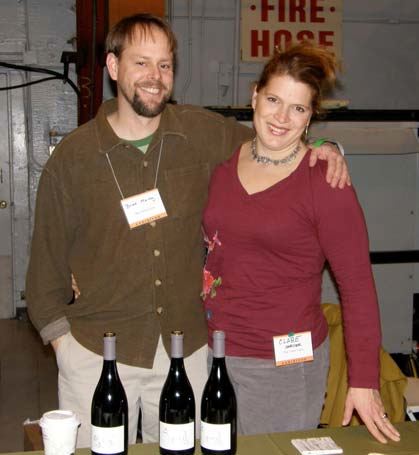
Beyond making remarkable wines, the couple have established a working farm where they raise pigs, cows,
meat and egg-laying chickens, and have working horses. The name, “Big Table Farm,” reflects the owners’
desire to provide a welcoming table for themselves and their friends, laden with artisan foods and wine. Some
of the farm-raised animal products will eventually become available commercially.
The lineup of wines have varied each year and the 2009 Laughing Pig Pinot Noir Rosé, 2008 Willamette Valley
Pinot Noir and 2008 Resonance Vineyard Willamette Valley Pinot Noir have been previously reviewed
(www.princeofpinot.com/winery/964/). Most labels feature a drawing of a single farm animal and are quite
stylish. They are fashioned by hand using a letterpress, then cut and glued onto each bottle. Besides the
wines reviewed below, a 2009 Riesling from Brooks Estate Vineyard and a 2007 Syrah from California’s White
Hawk Vineyard are offered. A 2009 Willamette Valley blend will be released in the spring 2011.
Big Table Farm wines are sold primarily through a mailing list at www.bigtablefarm.com. The website is very
informative and one of the most modern and well-designed winery websites I have ever visited. The winery
and farm are open only by appointment (503-662-3129).
I must admit to being smitten by not only the quality of Big Table Farm wines, but the way the owners stand out
as truly personal and talented individuals with generous joie de vivre, and a commitment to sustainable farming
traditions. This is the type of small producer we want to, need to, and have to support.
2009 Big Table Farm Cattrall Brothers Vineyard Eola-Amity Hills Willamette Valley Pinot Noir
13.7% alc, 100 cases, $45. Label features a grape delivery
truck owned by the Cattrall Brothers, a 1947 Ford. From the oldest certified
organic vineyard in Oregon, planted in the 1970s. Unfined and unfiltered.
·
Moderately light reddish-purple color in the glass. Lovely aromas of cherries,
strawberries, red roses and sandalwood. Delicate but tasty core of red fruits with
strawberry flavor at the forefront and toasty oak and baking spices adding interest
in the background. A charming wine with admirable balance that is drinking
nicely now. Very Good.

2009 Big Table Farm Resonance Vineyard Yamhill-Carlton District Willamette Valley Pinot Noir
14.8% alc., 190 cases, $48. Label sports
picture of Haley the cow with first calf born at Big Table Farm spring
2010. Pommard, Wädenswil and Dijon 777 clones. Fermented with
natural yeast, some pigeage, and aged sur lie in French oak. Unfined and
unfiltered.
·
Moderately deep garnet hue in the glass. Boisterous and
alluring aromas of dark, rich Pinot fruits that just won’t quit. Delicious attack of
dark berry jam with ever changing additional layers of flavor that include anise,
lavender and Asian spice. This is a wine of discovery, revealing more interest
with each sip. The tannins are reigned in making for approachability now and
the succulent fruit is hard to resist, but this wine will get better with cellaring. Fabulous goût de terroir.
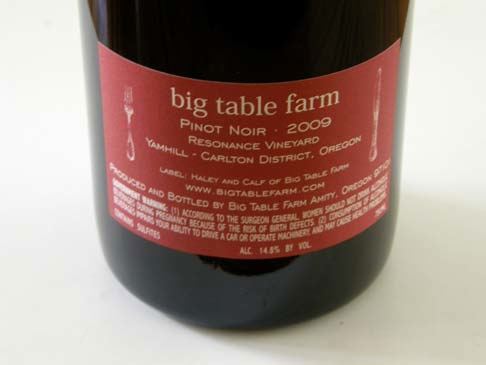
Bruliam Wines
Southern California
Two novice, but enthusiastic winemakers, Kerith and Brian Overstreet, debuted their label beginning with the
2008 vintage. I have never seen a couple having so much fun in launching a wine business. Brian is the CEO
of fast-growing Sagient Research Systems, a leading provider of proprietary independent research and data
services to the financial and institutional investment communities, and Kerith, a former surgical pathologist,
manages the family of three kids. Their occupational success allows them to donate 100% of their profits from
their wine sales to the Overstreet Family Foundation which has multiple charitable beneficiaries.
Their name and label is a colorful play on The Periodic Table of Elements (remember your high school
chemistry?). Kerith and Brian consider wine elemental to their life. Bruliam is an amalgamation of the names of
the three young Overstreet children.
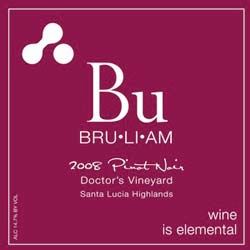
The inaugural release from Bruliam was a 2008 Doctor’s Vineyard Santa Lucia Highlands Pinot Noir which was
crafted at Crushpad in San Francisco (previously reviewed - www.princeofpinot.com/winery/621/). For 2010,
production was moved to Mauritson Winery on Dry Creek Road in Healdsburg. The Overstreets conveniently
have a second home in Healdsburg so they have easy access to the Mauritson production facility. Winemaker
Clay Mauritson acts as the consultant for Bruliam wines. He is an accomplished vintner who has made
distinguished wines under his Mauritson Winery, Rockpile and Loam brands and has teamed with restaurateur
Charlie Palmer to craft the Charlie Clay and Duelist brands of Pinot Noir. Kerith recently worked harvest at
Mauritson and her amorous escapades with the heartbreak grape are chronicled in a video posted on the
winery’s website.
I recently attended a lively release party for the 2009 vintage Bruliam wines at Cucina Urbana Restaurant in
San Diego. I sampled the three Bruliam Pinot Noirs offered and was impressed by the easy approachability of
the Anderson Valley and Santa Lucia Highlands bottlings. All three wines have much to recommend. The
wines are sold through a mailing list at www.bruliamwines.com.
Bruliam wines are made in traditional fashion. After hand sorting and de-stemming and a 5-day cold soak,
whole berry inoculated fermentation is carried out. The barreled wine is 70%-90% free-run. Malolactic
fermentation is initiated with inoculated yeast and the wine is aged for 11 months in 33% to 50% new French
oak barrels. The wines were bottle aged 3 months before release on December 5, 2010.
The Bruliam blog is penned by both Brian and Kerith and is one of my favorite reads on the internet. My wife
has curiously checked on me a few times after hearing me burst out laughing while reading the blog.
2009 Bruliam Hayley Vineyard Anderson Valley Pinot Noir
14.2% alc., pH 3.73, $52. Unusual wine in that
it is 100% clone 114.
·
This Pinot is the most feminine, the angel of the lineup. Very pretty perfume of cherries,
strawberries and spice echoed in the flavors on the palate. Soft, forward and charming, with a spark of acidity
to enliven the cherry driven finish. Very Good.
2009 Bruliam Doctor’s Vineyard Santa Lucia Highlands Pinot Noir
14.3% alc., pH 3.55, $52. Aged for 11
months in 50% new Franch oak from Remond. Clones 828, 777, 667 and Swan.
·
This is a crowd pleaser and
a little more substantial tease with its exuberant scent of black cherries, dark red berries and forest floor. The
tasty fruit is well robed in suede tannins creating an invitingly smooth mouth feel. Like eating kirsch-soaked
cherries on a velvet blanket. Very Good.
2009 Bruliam Split Rock Vineyard Sonoma Coast Pinot Noir
14.3% alc., pH 3.82, $52. Fermented as
100% clone 667 with small amounts of clones 115 and 828 added at blending.
·
Rugged and muscular, this wine
offers a bold array of earth-kissed, fleshy and savory dark stone fruits. As is typical for clone 667, the color is
strong and intense and the tannins are firm and angular. Will appeal to fruit hedonists. Put this one in your
cellar while you drink the Hayley and Doctor’s wines. Good.
de Coelo by Benziger Family Winery
Sonoma Mountain, California
Benziger Family Winery is a very large producer, but the de Coelo (day-chay-lo) label is a small project within
the winery that is centered on the estate de Coelo Vineyard located in the true Sonoma Coast. Perched on a
rugged hilltop five miles from the Pacific Ocean, the rocky, shallow soils and the cooling fog off Bodega Bay
create ideal conditions for growing Pinot Noir. The 25-acre, Biodynamic® certified de Coelo Vineyard is truly
on the edge of where Pinot Noir will grow. The vineyard name means “that which is from heaven,” a name
befitting an estate that nurtures intensely flavorful fruit and a wine of rich concentration and complexity.
Rodrigo Soto, the Vice President of Winemaking at Benziger Family Winery, is spearheading the winery’s
certified organic and biodynamic Signaterra and de Coelo Pinot Noir labels. A graduate of the agronomy
program at Chile’s Catholic University, he has extensive international winegrowing experience with organic and
biodynamic wineries including work at Matetic Vineyards in Chile and Fetzer Vineyards in California.
The de Coelo vineyard is a project still in development. The lower 5-acre section, called Quintus, is planted to
Dijon clones 667, 828 and a Swan selection. The upper steeper 10-acre section, named Terra Neuma,
contains Dijon clones 115 and 777. A distinct de Coelo Pinot Noir is made from these two parcels of the
vineyard. A third, more exposed and windy site, consists of 5 acres of younger vines (Dijon clones 115, 777
and 828) that will eventually provide a third wine from the property.
The de Coelo Pinot Noirs are serious wines of the earth, full of intrigue and nuance that are worthy of their
origin and provide a unique drinking experience. Benziger touts them as more Old World or Burgundian in
style than Caliesque, and I think that is a good fit.
Soto’s winemaking is traditional using some whole cluster, indigenous yeast fermentations, and aging for 12
(Terra Neuma) to 16 (Quintus) months in 50% new French oak barrels. The wines are unfined and unfiltered.
Production is about 550 cases of each de Coelo wine.
The wines are sold on the website at www.benziger.com. Prices are in line with the tremendous cost of farming
this marginal Sonoma Coast site. The impressive Sonoma Mountain Benziger tasting room is open daily and
special vineyard tours and tastings are available by appointment (707-935-4527).
2008 de Coelo Quintus Sonoma Coast Pinot Noir
14.1% alc., $69.
·
Moderate
reddish-purple color in the glass. Remarkably nuanced aromatic profile
featuring scents of black cherries, spices, mocha java, smoky oak and exotic
purple flowers. A wine of the earth with loam-infused black cherry and berry
flavors, a hint of tar, dusty tannins and bright acidity that lifts the rustic finish.
Clean and silky with many years of life ahead. Very Good (+).

2008 de Coelo Terra Neuma Sonoma Coast Pinot Noir
13.5% alc.,
$69.
·
Moderate reddish-purple in the glass. Exotic and complex nose
offering scents of wild berries, truffle, wine cask and forest floor. Luscious
core of dark berries that cling to the finish. Earth, mineral, oak and cola
undertones add interest. The fruit is vivid, framed by soft tannins and complimented by
crisp acidity. A seamless wine that picks up interest over several hours in
the glass. A Pinot Noir unbridled by convention.
Gypsy Canyon
Sta. Rita Hills, California
Over 100 years ago, the first known woman winegrower in California, Dona Marcelina Felix Dominquez,
farmed Mission vines on her Santa Barbara County property. The vines survived after years of neglect, and
when Deborah Hall, a former nurse, and her late physician spouse, William, bought the secluded property in
Gypsy Canyon off Highway 246 in Lompoc in 1994 as a retirement retreat, they discovered the vines under a
heavy cover of brush. Hall has named the 3-acre ancient Mission vineyard Dona Marcelina’s Vineyard
(pictured below), and today, it is the oldest producing vineyard in Santa Barbara County. Using a recipe for
fortified dessert wine written in 1891 by Emile Vache, Hall crafts a Gypsy Canyon Ancient Vine Angelica, a
similar, rich wine from her Mission grapes. This is one of the most distinctive, limited and meritorious wines
being produced in California today.
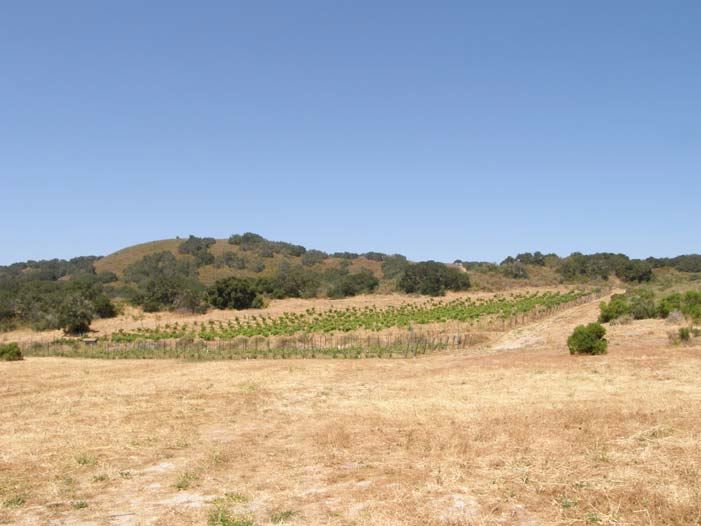
The Gypsy Canyon property consists of 130 acres with 6 acres of vines in the Santa Rita Creek Vineyard
planted to Pinot Noir (Dijon clones 115 and 777) and Pinot Gris. The site has an exceptionally cool
microclimate compared to other vineyard sites in the Sta. Rita Hills AVA. Farming is challenging with local deer
and birds eager to feast on the grapes. The 2007 vintage was completely lost to deer. Most work is done by
hand and is both organic and biodynamic.
Hall is grafting Pinot Noir onto a few select ancient Mission vines, creating the oldest known California Pinot
Noir vineyard. The wine produced will be named Nineteenth Century Sta. Rita Hills Pinot Noir. The very
limited availability will be sold to current subscribers.
Hall crafts her wines at Central Coast Wine Services in Santa Maria. She says, “I don’t set out to make a
specific style of Pinot Noir, but rather let the nuances of nature guide me.”
The first release of Gypsy Canyon Pinot Noir was in 2004. The Gypsy Canyon package is striking and shows a
nod to early California history. Hall uses a hand blown glass bottle of historically correct shape with an
embossed glass seal, a handmade paper label, and a beeswax seal. Each bottle is signed by Hall. Magnums
are particularly impressive. The historical aesthetic adds to the appeal of the wine inside.
Beginning in the spring of 2011, Hall will offer a Collector’s Edition of Ancient Vine Angelica presented in
museum quality antique bottles ranging from 300 to 400 years old. The history of each bottle as well as a
certified appraisal will be included. Subscribers will be given priority.
The 2008 Gypsy Canyon “Trois” Pinot Noir reviewed below consists of just three barrels of purchased grapes
from an unnamed but prestigious Sta. Rita Hills vineyard and three barrels from the estate Santa Rita Creek
Vineyard. The finished wine is a 50/50 blend of the two lots. The wine immediately sold out, but you can sign
up to receive an offering of Trois 2009 which is to be released in the fall of 2010. I was really taken by the Trois
2008 and shared it with some friends and a sommelier who were also stoked.
Gypsy Canyon wines are sold exclusively through a mailing list. You may join the waiting list by e-mail
(concierge@gypsycanyon.com) or phone (805-737-0204). The winery website is www.gypsycanyon.com.
Tasting of the winery’s Pinot Noir and Angelica are available by appointment for a small charge. The wines are
expensive, but their unique historical background and expense involved in production certainly justify the cost.

2008 Gypsy Canyon Trois Sta. Rita Hills Pinot Noir
14.0% alc., 75 cases, $95.
Bottled in a newer more substantial glass than previous vintages.
·
Moderately deep reddish-purple color in the glass. Very lovely perfume of
black cherries spiced with coriander, savory and sweet smoke.
Superlatives don’t do this wine justice. Luscious melange of dark berries
and plums with a subtle underpinning of oak and tobacco. A welcoming
silky texture and a bombastic peacock finish adds to the pleasure. Quite
different from previous Gypsy Canyon bottlings with more backbone and fruit
intensity but still showing plenty of feminine charm. Great winemaking at work
here. Man, what a wine.
NV Ancient Vine Angelica Dona Marcelina’s Vineyard Sta. Rita Hills Mission Dessert Wine
17% alc., 9%
residual sugar, 25 cases, $130 (375 ml). Raised two years in neutral barrels.
·
Save this
wine for a special cool evening by the fireplace. Flavors of root beer, roasted nuts and caramel toffee seem to
last an eternity on the finish. Drinks more like a dry wine than a dessert wine with refreshing acidity. Pair with
5-year-old Gouda cheese for an orgasmic experience. This is surely one of the most exotic and rare beverages
I have ever drank. Very good (++++).
Harrington
San Francisco Bay, California
Proprietor and winemaker Bryan Harrington hand crafts small lots of vineyard-designated Pinot Noir from
purchased grapes in an urban warehouse winery located in the Produce District of San Francisco. I first
became enamored by Harrington Pinot Noirs after tasting them at the World of Pinot Noir in 2006. The wines
stood out for their individuality and deft winemaking.
While working as a bartender in San Francisco, Harrington traveled to Europe and was captivated by the very
small producers of wine who were tending tiny vineyard plots and crafting a few barrels of wine. It was a model
that he eventually was to pursue. He began making wine in his basement, attended several University of
California at Davis classes, and moved on to a cooperative winemaking facility in Berkeley. He launched his
own label in 2002 and later settled into his present location in San Francisco.
Harrington wines are crafted in an artisan fashion with no wine made in larger than a 300 case lot. All
production decisions, the majority of labor performed, and the ownership of the means of production are under
the control of one person. Bryan says, “It is my responsibility each year to use every means possible to bring a
fruit-full and authentic wine experience to your glass.”
Most Harrington vineyard sources are aged and planted to California’s older heritage clones. Vineyard sources
have varied in different vintages, but they have all been exemplary. “Vineyard sources have been chosen not
only for their age and quality, but also for their ability to convey those characteristics that typify the particular
Pinot Noir appellations, whether it be the firm structural elements of wine from the limestone of Chalone, the
dark fruit flavors of the Sonoma Coast rocky ridge tops, or the racy Bing cherry profiles from the Goldridge soils
of the Russian River Valley. The winemaking approach is biased to accumulate the particular flavors and
aromatics natural to each site.”
Harrington promises and he delivers. Each wine speaks of its terroir and has a distinctive personality. Beyond
this, the wines retain an appealing finesse that makes Pinot Noir irresistible. There is no heavy handiness at
work here. All the 2008 wines are very approachable. Prices are sensible. The wines are sold by e-mail or
phone at www.harringtonwine.com (415-824-1824). There is a growing list of wine bars, restaurants and
retailers that carry Harrington wines and the list is offered on the website. Winery open houses are offered
periodically as well. In 2008, Harrington has added a Nebbiolo which is also reviewed here. Bryan is pictured
below left pouring at the Anderson Valley Pinot Noir Festival.
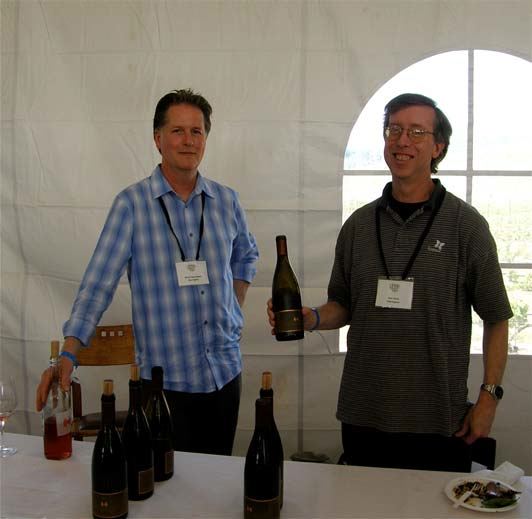
2008 Harrington Paso Robles Nebbiolo
14.3% alc., pH 3.57, 60 cases, $30.
Sourced from two Templeton Gap vineyards (Luna Matta and AJB). Aged 16
months in neutral French oak barrels.
·
Moderately light ruby color in the glass.
Aromas of black berries, dried herbs, tar and mushrooms. Lightly weighted
and delicately spiced tart cherry, berry and cola flavors with forceful tannins
and a brisk charge of acid on the finish. A nicely flavored early drinking type of
Nebbiolo rather than a big Barolo style. One of the better examples I have
tasted from California and shows that Nebbiolo doesn’t have to come from
Piedmont. Pair with lighter meat dishes and charcuterie. Good.

2008 Harrington Krause Vineyard San Francisco Bay Pinot Noir
14.2% alc., pH 3.50, 175 cases, $35. This Krause Vineyard was planted
in 1998 and covers 1.75 acres of Pinot Noir. The clones are Martini,
Calera, Mt. Eden and Dijon 115. Aged 10 months in French oak barrels.
·
Aromas of earth-kissed dark cherries and berries with hints of tea and
seasoned oak. Intense and pleasing cornucopia of black cherries and
ollaliberries lingering on the dry and fruit-filled and generous finish. Very
smoothly textured and a delight to drink. Still great two days later from a
previously opened and re-corked bottle.
2008 Harrington Gap’s Crown Vineyard Sonoma Coast Pinot Noir
14.3% alc., pH 3.36, 175 cases, $40.
This well-known vineyard is located at the southeastern edge of the Petaluma Gap in the town of Penngrove.
The soil is extremely rocky which stresses the vines. The prevailing wind and fog keep the grapes high in
acidity while flavors develop. Clones are Dijon 828 and 115.
·
Moderately dark reddish-purple color in the glass.
A cherry themed nose offers added nuances of dark rose petals and exotic roasted coffee. Bright and hightoned
flavors of dark red cherries and berries are sweetened with oak and end with a citric peel and cherry skin
finish. More restrained and delicate than the other 2008 Harrington Pinot Noirs, achieving more interest over
time in the glass. Very Good.
2008 Harrington Iund Vineyard Carneros Pinot Noir
14.0% alc., pH 3.41,
100 cases, $35. Martini clone. Aged 10 months in 20% new French oak barrels.
·
Moderately intense reddish-purple hue in the glass. A wonderful potpourri of
ripe dark berries accented by notes of spice, dark chocolate and oak. The fruit
is strikingly vivid and is encased in silky, fine-grain tannins. There are plenty of
oak-derived flavors here but they compliment the fruit nicely. The whole
package is very soft in the mouth and finishes on a very clean note. Very Good.
2008 Harrington Brousseau Vineyard Chalone Pinot Noir
14.2% alc., pH 3.54, 125 cases, $40. This
vineyard is located within a mile of the Pinnacles National Monument and is known for the limestone strata in
the soils. Clone 538. Aged 10 months in French oak barrels.
·
Moderately dark ruby color in the glass. Aromas
of blackberry jam, bay leaf, cut flowers and green garden. Rugged core of blackberry and black plum fruit with
underpinnings of earth, cola and seasoned oak. The unbridled tannins are typical of this vineyard as is the
unshaven character. The wine shed its whiskers and drank much better with softening of tannins and
emergence of more charm two days later from a previously opened and re-corked bottle indicating this wine
should be decanted if opened now. Very Good.



